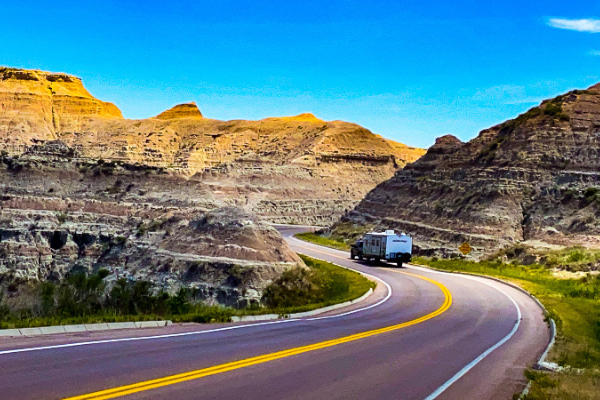

About 1 million people a year make the trek to a remote portion of South Dakota to visit Badlands National Park, and recently we found out why! With its combination of stunning overlook vistas, unique rock formations and interesting hikes, the Badlands ranks high on our list of favorite National Parks.
The park is small enough to see in 1-2 days, making a perfect weekend excursion for many people.
History Of Badlands National Park
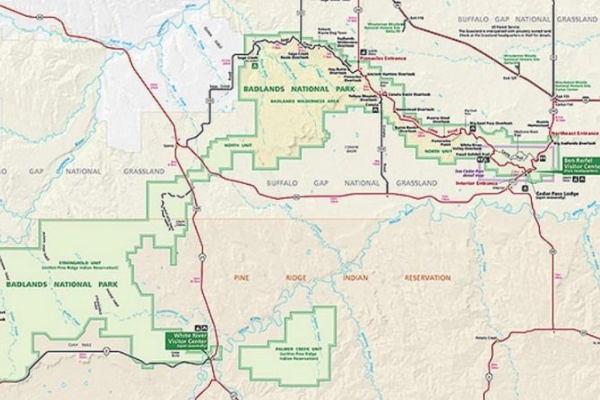
Like many areas in the American West, the name for Badlands National Park actually originated with Native American tribes who called the area home for thousands of years. The Lakota tribe was the first to name this remote area “mako-sica,” which translated means “land bad.”
You see, extreme temperature variations, the scarcity water sources, and the difficult land topography combined to make this a challenging landscape for these indigenous peoples. But they were able to thrive in this area, and archeologists are still uncovering arrowheads, tools, and other items used by these individuals hundreds of years ago.
Badlands was established as a national monument in 1939 and was designated as a national park was formed in November 1978 and currently protects approximately 380 square miles of South Dakota. Part of the park (the South Unit) is controlled by the Oglala Lakota Tribe.
Unique Geography Of Badlands National Park
The topography of the area is one of the things that makes the park so unique. Its collection of pinnacles and buttes (caused by years of erosion) create a rather dramatic visual landscape. In fact, erosion still plays a role today as the Badlands wall continues to recede more and more every year.
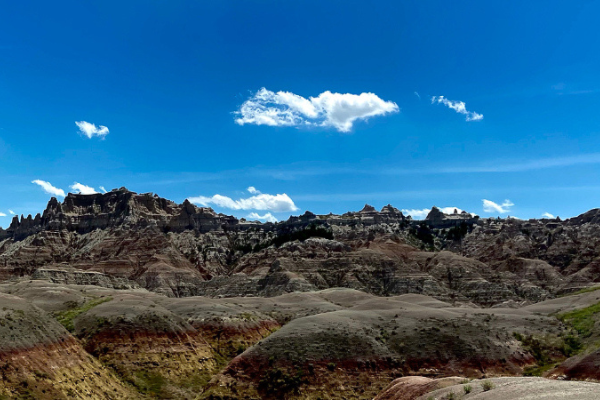
Running along the northern and western edges of the park is the Buffalo Gap National Grasslands. This area is one of 20 national grasslands in the United States and encompasses 931 square miles of land. Established in June of 1960, the area is managed by the U.S. Forest Service and was formed to provide grazing land for bighorn and pronghorn sheep. Also, the area boasts the most successful reintroduction of the black-footed ferret in America.
Many of the features of Badlands National Park can be seen while driving the Badlands Loop Road (Highway 240), which runs through the park.
Wildlife In Badlands
Although rugged, the park is home to a variety of wildlife. Bison roam freely in the park, as do pronghorn sheep. Prairie dog towns can be found scattered throughout, and the endangered black-footed ferret also calls the park home. Wildlife can often be seen from the Badlands Loop Road, but for more specific areas, the park website states that “bison are best seen from Sage Creek Rim Road,” which overlooks the Badlands Wilderness Area where they live. Bighorn sheep are often seen on the rocky precipices of Pinnacles Overlook and in Cedar Pass areas like Castle Trail and Big Badlands Overlook.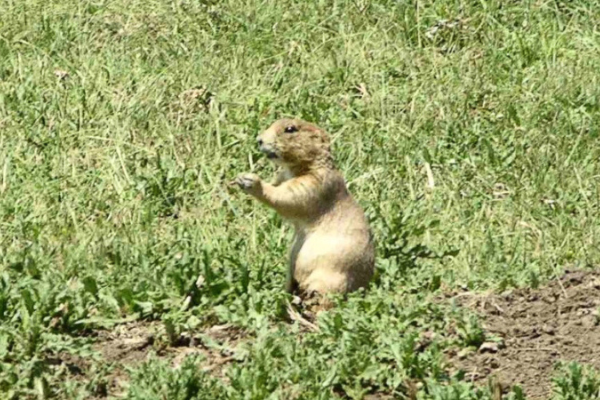
Prairie dog towns exist throughout the park and can be viewed from the road at Burns Basin Overlook, Roberts Prairie Dog Town, and Sage Creek Campground.”
How to Explore Badlands National Park
Scenic Drives In Badlands
Badlands National Park boasts several distinct scenic drives, and we would recommend…all of them!
The Badlands Loop Road (aka Highway 240) runs through the park from the Pinnacles Entrance (northwest corner of the park) to the Interior Entrance and Ben Reifel Visitor Center (southeast corner). This drive isn’t a true loop like the name suggests; rather, it is a scenic drive through the park that connects to Interstate 90 on each end of the highway, thereby forming a “loop.” This scenic drive features 12 different overlook areas that each offer a distinct view of the park’s unique geography. We entered from Wall, South Dakota, via the Pinnacles Entrance, so the Pinnacle Overlook was our first stop…and was probably our favorite of the overlooks. But honestly, it’s hard to pick a favorite because they all offer a slightly different look at the Badlands.
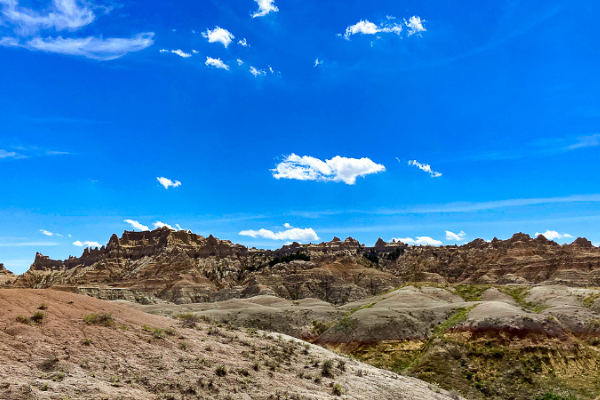
The Badlands Loop Road is approximately 40 miles in length, but by the time we stopped to take photos, look at wildlife, and deal with other traffic, it took us about 1 1/2 hours to make the drive. Of course, we were pulling our 36-foot travel trailer behind us (yep, the road is big enough for that) so your time may vary from ours. We exited the park via the “Interior Entrance” en route to the Badlands/White River KOA and encountered no real problems towing through the park. We did explore up to the “Northeast Entrance” the following day and noticed a couple of tight turns that could be challenging when pulling an RV, so be aware.

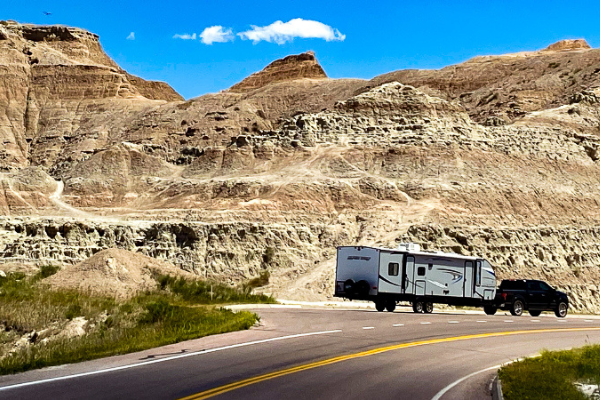
The Sage Creek Rim Road is a dirt/gravel road located in the Sage Creek Wilderness area of the park (northwest corner). If entering the park from the Pinnacles Entrance (like we did), turn right to enter the Sage Creek Rim Road. Since it is a dirt road, the park warns to avoid it during or immediately after storms due to the slick nature of the roadway. There are three scenic overlooks and a prairie dog town that is visible from the road. While the overlooks are nice, the main attraction in this area is wildlife. Bison, prairie dogs, pronghorn sheep, and multiple varieties of birds are frequently seen in this wilderness area.
Hiking In Badlands National Park
One of the interesting and unique things about Badlands National Park is the Open Hike Policy that is embraced here. While many other national parks restrict hiking to only officially posted trails, in the Badlands you are free to wander and hike anywhere that you can safely visit. Not only is off-trail hiking allowed but it is even encouraged, and no backcountry fees or permits are required.
If officially marked trails are more your style, the park has many to choose from…everything from easy boardwalk style to moderate 10-milers. Three of the parks most popular trails are located near the Ben Reifel Visitors Center: the Door Trail, Window Trail, and the Notch Trail.
The Door and Window trails are both considered easy (0.75 and 0.25 miles, respectively). The Door Trail is boardwalk style while the Window trail is gravel. Both offer unique looks through the Badlands “wall” at the canyons that make up this vast landscape.
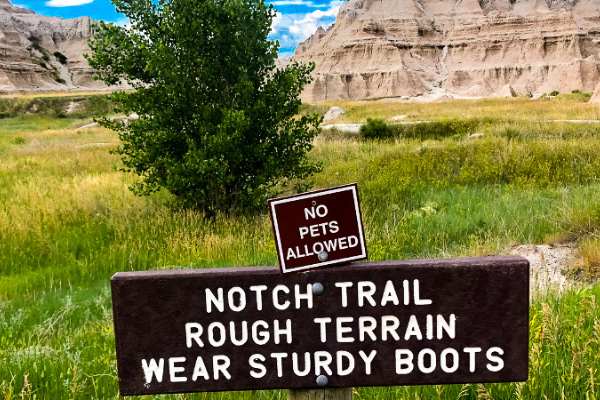
The Notch Trail is a unique adventure that our whole family enjoyed. At 1.5 miles (round trip) the hike is rated moderate to strenuous, but we found the moderate description to be more accurate. Leaving the parking lot, the trail winds through the canyons that make up the Badlands and finally arrives at a steep log ladder that leads to the top of a ridge above. At first the “ladder” is a simple walk, but after a few feet it begins to climb steeply, and you wind up climbing with your hands and feet before long!
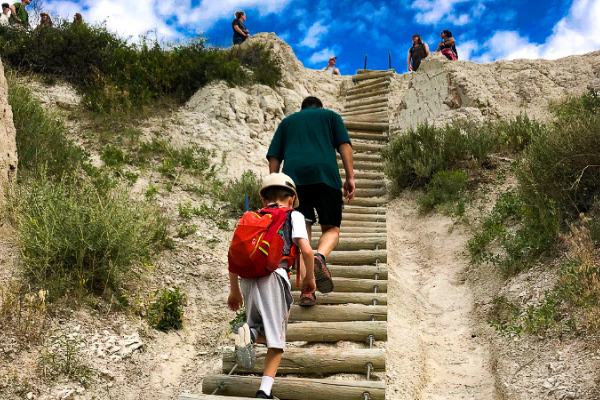
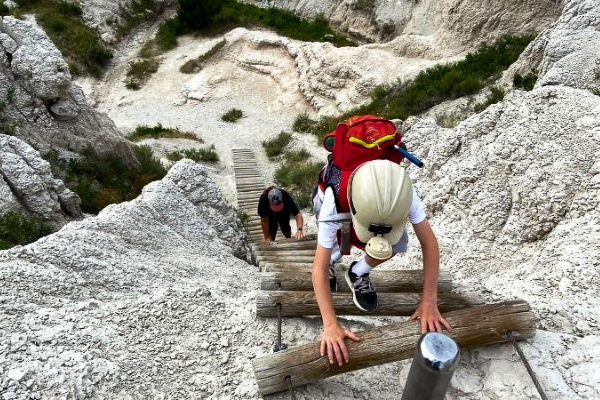
After your harrowing ascent (OK, it’s really not that bad…it’s more fun than scary), the trail continues along the ridge until you arrive at the “Notch.” Our family prefers hikes with some sort of payout…maybe it ends at a nice waterfall, or a scenic vista…and the Notch trail delivers. “The Notch” is basically a large opening high on the ridge that provides a stunning view of the valley below…definitely worth the hike!
After pausing for a drink and some pictures, you retrace your steps back to the parking lot where you started…yep, that means climbing back down the ladder!
Camping Inside Badlands National Park
Badlands National Park features two distinct campsites.
Cedar Pass Campground is located adjacent to the lodge and consists of 96 separate campsites. Tent and RV sites are available, and reservations can be made online (except for group sites; see below). A few things to note…
- All sites contain shaded picnic tables
- Other than the tables, no shade is available at any site in the campground.
- RV sites have ELECTRIC HOOKUPS ONLY. No water or sewer is available at the sites.
- An RV dump station is located on site, and a $1 fee is required for use.
- Rest rooms are located on site, with PAID showers available.
- Four group campsites are available and can be reserved by calling the lodge directly: (605) 433-5460

Sage Creek Campground, on the other hand, is a first-come, first-served campground on the other side of the park west of the Pinnacle Entrance. It offers 22 sites with no hookups or water available. Due to its remote location (several miles down Sage Creek Rim Road) no motorhomes, pull-behind trailers, or other RVs longer than 18 feet are allowed.
Camping Outside Badlands National Park
Due to the hookup (water/sewer) and size limitations in the park, we elected to camp just outside the Interior Entrance, near the Cedar Pass Area at the Badlands/White River KOA Holiday for the second half of our Badlands visit. This private campground was less than 10 minutes from the park entrance and easily met all of our needs. Overall, we found the campground more than adequate. We enjoyed having full hookups, and having access to a pool in such an arid climate is a treat…not to mention Wi-Fi! Most importantly, Sandi enjoyed having a site with some shade!
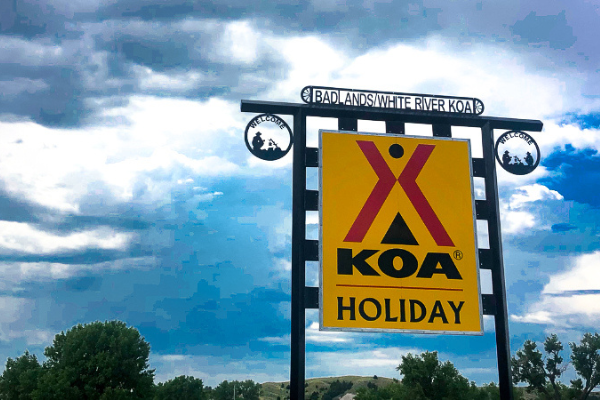

Before entering the park, we boondocked at an epic location just north of the Pinnacle Entrance, literally right on the Badlands Wall. Check out our posts on how this breathtaking site was almost an epic fail, and why it may be our favorite camp spot of all time!
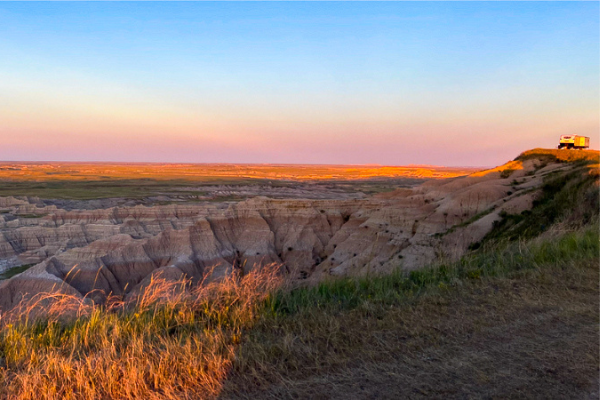
|
Hi, we’re Kim and Matt, and together we make up S’more Time Together. We are a normal American family just like you…working a full-time job, balancing family life, and dreaming of traveling to places we’ve never seen. We try to make the most of our time off by traveling as a family and savoring all the precious moments that come our way. We invite you to come along on our journeys as we share unique destinations, campground reviews, and adventures you can enjoy as a family. You can find us on the web at our S’more Time Together blog, on Instagram and Pinterest (YouTube coming soon!). Join the community and follow along as we encourage you to make s’more time together with the ones you love! |


Leave a Reply